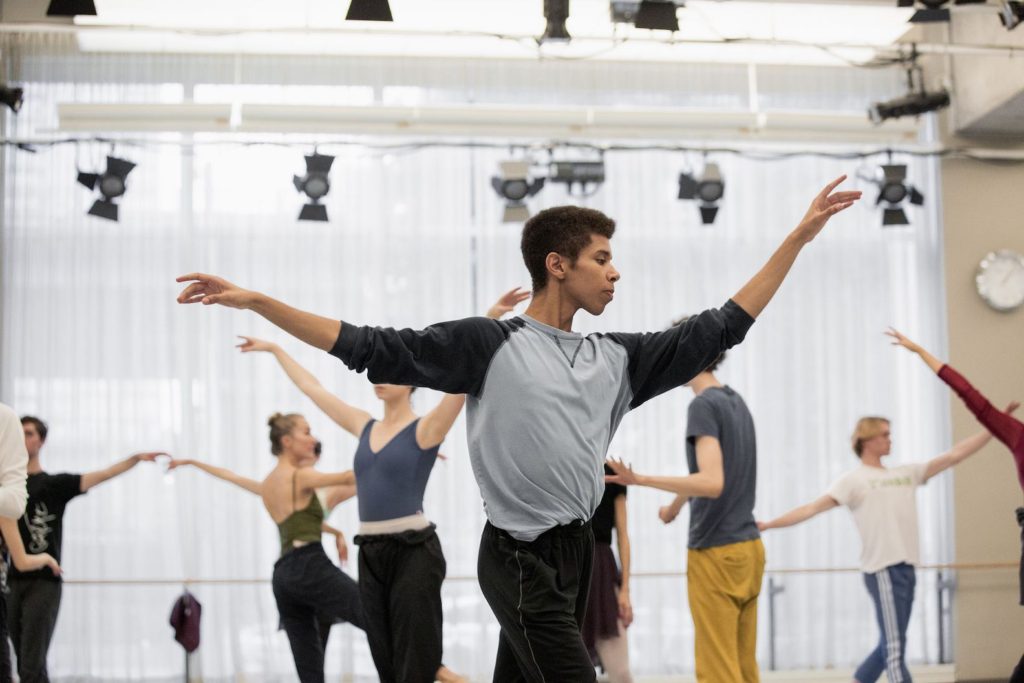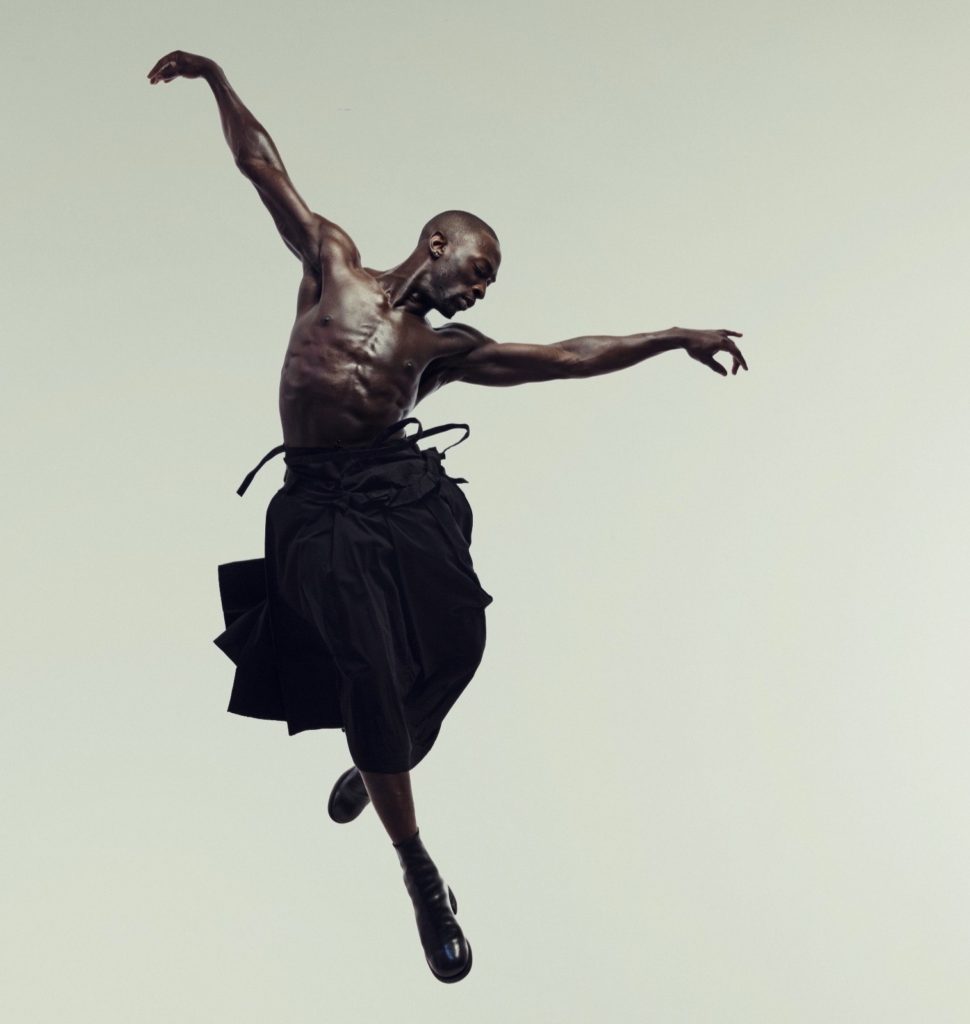Pursuing Grace in a Politically Charged Time: Two dancers of colour who are flourishing - Vancouver Ballet Society
- Home
- Features 2020 - 2023
- Pursuing Grace in a Politically Charged Time: Two dancers of colour who are flourishing

By Jenn Edwards
Dancers thrive on gathering. The gathering of bodies in the studio, onstage and in the audience is what defines the art form. When a global pandemic put a stop to all of this, there was a collective sense of loss in the community. And when people did start to gather again in June, it was often to protest police brutality and show solidarity with the Black Lives Matter movement. In a whirlwind few months, we were immobilized by a pandemic and then mobilized by protest.
Below, two dancers of colour — Alexander Skinner, who is just beginning his career at the National Ballet of Canada, and Gilbert Small, who is starting a new chapter in Seattle after ten years with Ballet BC — share how they fell in love with dance and how their paths have intersected with the pandemic and Black Lives Matter.
Alexander Skinner, National Ballet of Canada, corps de ballet, Toronto, Ontario
The first sign that Alexander Skinner might become a dancer was when his parents noticed him mimicking Elvis Stojko’s televised figure-skating routines as a toddler. Initially, though, Skinner was more involved in sports, playing on hockey and soccer teams in Ottawa, where he was born and raised. There were also trips to Italy, where his maternal grandparents were born, and to Barbados, his paternal grandparents’ birthplace, which gave him a sense of pride in both sides of his family heritage.
After trying hip hop for a few years, Skinner stepped into his first ballet class at 13. “When I got to ballet, everything kind of clicked,” he says.

At 15, he moved to Toronto to train at Canada’s National Ballet School, allowing him to focus on both dance and academics under one roof. At the School of Dance where he trained in Ottawa, he had been one of only three boys. But at NBS, he says, “My ballet classes were only with boys, which allowed the training to be focused on meeting the demands and expectations of male dancers.”
Having started his training quite late compared to most classical dancers, Skinner wasn’t sure at the time whether professional dance would be an option. “There was some catch up to do in terms of technique,” he says. Apparently he caught up, as he became an apprentice at the National Ballet in 2017 at the age of 19, and a corps de ballet member the following year.
The momentum of the past few years came to a halt this spring, when the pandemic cut the dance season short. Skinner spent the lockdown in Ottawa with his family, where he has been taking daily company class with his colleagues on Zoom, and has appeared in a few digital projects. One was An Anthem to Canadian Dance, a video released on Canada Day by the Globe and Mail, featuring several Canadian dance groups performing outdoors to a Leonard Cohen song.
As a young bi-racial male, this time has also been one of reflection for Skinner. As protests and statements of solidarity with Black Lives Matter surged worldwide in reaction to the murder of an unarmed Black man, George Floyd, by Minneapolis police, a colleague in the corps de ballet released an emotional Instagram video (which is no longer available) calling out the National Ballet of Canada on their silence in the wake of the tragedy. After the video, Skinner says conversations around systemic racism opened up within the company, with regular town hall meetings inviting racialized dancers and staff to share their concerns and ideas for future growth.
While the 22-year-old has been engaging in political conversations with the company, family and friends, Skinner has also been using this time to go inward, finding solace in yoga and writing. “Without all of the distractions of normal life, this has given me a lot of time to just think,” he says.
Gilbert Small, independent dancer, Seattle, Washington
Gilbert Small’s passion for dance shone through in an after-school program in Baltimore, where he was raised, with his third-grade teacher the first to encourage him to pursue it. “She helped me trick my parents for about a year and a half because my father didn’t want me to dance, and I really needed to dance,” he says. Small’s parents were eventually brought on board, and he studied ballet and modern dance at the Baltimore School for the Arts during his high school years. Later, he attended the Conservatory of Dance at Purchase College in upstate New York, as well as studying abroad at Codarts in Rotterdam.
In 2008, while Small was still a student, he danced in Toronto for Pro Arte Danza, where he met guest choreographer Emily Molnar. The following year, when Molnar became interim artistic director of Ballet BC, she offered him a contract. The decision to move to Vancouver was a leap of faith for Small, because at the time Ballet BC was a struggling company with a very short season. Over the decade he spent with the small contemporary ballet group, they skyrocketed on the international stage.

For his first two years on the west coast, Small also danced for Sidra Bell Dance New York during gaps in Ballet BC’s schedule. “I would get videos of material to learn, and then as soon as Ballet BC projects wrapped up I would be on a plane to New York. I believe doing that kept me inspired… I was always coming back with new information.” His final season with Ballet BC followed a similar pattern, with weekends spent in Seattle, which was starting to become his new home.
Now 33, Small lives full-time in Seattle with his partner of three years, branching out into projects that resonate with him. In 2019, he joined an all-black cast for Dani Tirelle’s Black Bois, a piece billed as “a love letter to black bodies, minds and spirits.” He has also been dancing with zoe | juniper, an experimental company founded by choreographer Zoe Scofield and visual artist Juniper Shuey. In addition, he has been teaching emerging dancers through the company’s training programs, and acting as assistant choreographer to Scofield. He values this experience as a stepping stone to eventually becoming artistic director of a dance organization, with plans to attend business school in the near future.
Seattle has been a vocal hub of support for Black Lives Matter. In early June, the CHOP (Capitol Hill Organized Protest) sprung up in one of the more progressive neighbourhoods, and Small was able to witness it firsthand before the Seattle Police Department dismantled the self-declared autonomous zone three weeks later. “It was really beautiful for Black folks and people of colour to gather, and hold each other and their feelings and for them to speak out… It’s sad to see the space, and what it cultivated, gone.”

